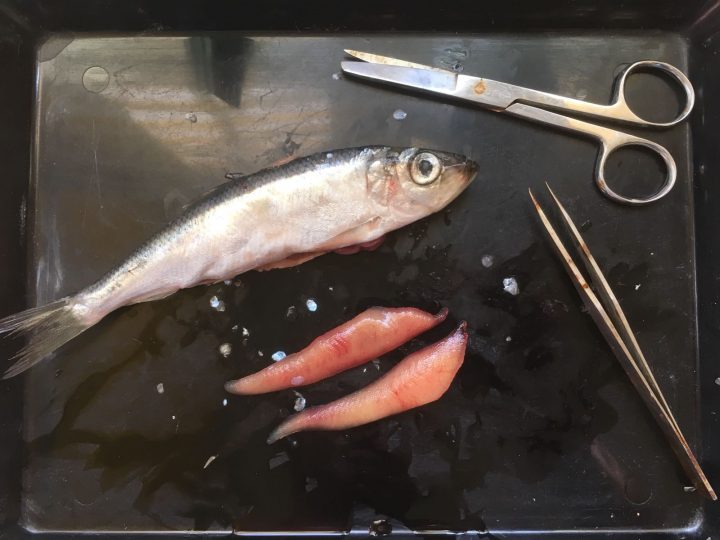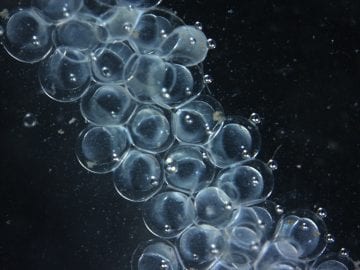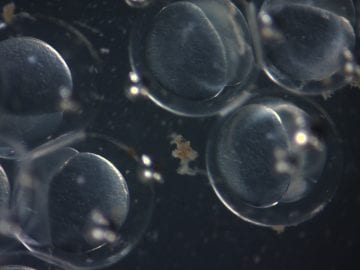Reproductive success
Adaptation to varied salinity conditions
Baltic herring (Clupea harengus membras) are highly adaptable and can spawn throughout the entire Baltic Sea, even in areas with nearly freshwater conditions. Research shows that herring eggs can be fertilized across a wide range of salinity levels. Optimal fertilization generally occurs at around 8 PSU (Practical Salinity Units), suggesting this may be the preferred salinity for successful reproduction.

Factors impacting reproductive success
Reproductive success in herring depends on several factors, starting with egg fertilization during spawning. The time from fertilization to hatching varies from a few days to several weeks, depending on water temperature. During this critical period, herring eggs are vulnerable to many threats, including, for example, predation by fish like perch and whitefish, which are common in the Archipelago Sea. In addition to predation and environmental stressors, our research has shown that maternal phenotype plays a crucial role in determining the survival and development of herring eggs.
Role of plant community composition on spawning beds
The type of plant species on spawning beds can significantly affect herring egg survival. Studies from Finland and Sweden have shown that egg mortality varies depending on the plant species used as a substrate. Some plants, such as certain brown and red algae, can release toxic substances during decomposition, increasing egg mortality. This process, known as allelopathy, highlights the importance of plant community composition in herring spawning habitats.
Influences of parental traits
Reproductive success is not only affected by environmental factors but also by the traits of the parent fish. Experiments have shown that there are differences among females in fertilization rates and embryonic survival, as well as variations among males in fertilization success. In some cases, the least successful females produced offspring with only 10% of the survival rates observed in the best-performing females. These findings suggest that parental traits play a key role in reproductive success. Building on previous findings, Mäkinen et al. (2023) demonstrated that maternal effects, such as size and muscle fat content, significantly influence not only fertilization rates but also larval quality and survival. The study found that at higher incubation temperatures, maternal traits had an even stronger effect on the success of offspring, suggesting that as the Baltic Sea warms, the importance of maternal quality may increase.
Egg composition and survival
The chemical composition of herring eggs influences their survival during development. Eggs with higher fat content, especially those rich in polar lipids, tend to survive better in the later stages of embryonic development. However, excessive amounts of triacylglycerols (TAGs), a type of storage fat, can increase early embryonic mortality. This suggests that while TAGs are important for energy storage, an imbalance may indicate deficiencies in other essential yolk components needed for successful development. Long-term data analysis (Rajasilta et al., 2021) demonstrated a strong relationship between environmental conditions, specifically winter temperatures and salinity, and variations in egg lipid content in Baltic herring. The study found that in years with higher salinity and warmer winter temperatures, egg lipid content was higher. These lipids are essential for supporting late-stage embryonic development and larval survival. The findings suggest that shifts in salinity and temperature, driven by climate variability, may significantly affect the nutritional quality of herring eggs, influencing overall recruitment success.
Role of female size and condition
The size and condition of female herring significantly influence egg quality and survival. Larger females generally produce eggs with better survival rates in early developmental stages. Females with higher condition factors (a measure of health and fat reserves) produce eggs with lower early mortality and higher overall hatching success. While female condition does not directly correlate with fertilization rates or late-stage mortality, it appears to enhance overall reproductive success.
Table: Correlation between female properties and reproductive success
| Parameter | Fertilization Rate | Early Mortality | Late Mortality | Survival | Hatching Success |
|---|---|---|---|---|---|
| Condition Factor | 0.24 | -0.570* | -0.101 | 0.301 | 0.434* |
| Somatic Condition | 0.376 | -0.446* | -0.247 | 0.467* | 0.507* |
| Muscle Fat (DWt %) | 0.039 | -0.503* | -0.167 | 0.406* | 0.398* |
*Note: Correlation coefficients marked with * are statistically significant (p < 0.003).
Related publications
- Mäkinen, K., Rajasilta, M., Ruuskanen, S., Karpela, T., Lauerma, A., Sahlsten, J. (2023). Effects of incubation temperature and maternal phenotype on Baltic herring eggs and larvae: An experimental study. Canadian Journal of Fisheries and Aquatic Sciences. Read More
- Rajasilta, M., Mäkinen, K., Ruuskanen, S., Hänninen, J., Laine, P. (2021). Long-term data reveal the associations of egg quality with abiotic factors and female traits in Baltic herring. Frontiers in Marine Science. Read More
- Laine, P. & Rajasilta, M. (1999). The hatching success of Baltic herring eggs and its relation to female condition. Journal of Experimental Marine Biology and Ecology. Read More
- Rajasilta, M., Laine, P. & Eklund, J. 2006. Mortality of herring eggs on different algal substrates (Furcellaria spp. and Cladophora spp.) – an experimental study. Hydrobiologia 554: 127-130. DOI 10.1007/s10750-005-1012-9. Read More
- Laine, P. 1999. Paternal effects on the hatching success of Baltic herring eggs. ICES J. Mar. Sci. 56 (Suppl.): 142-146.
- Laine, P. & Rajasilta, M. 1998. Changes in the reproductive properties of Baltic herring females during the spawning season. Fisheries Research 36: 67-73. Read More
- Rajasilta, M., Paranko, J. & Laine, P. 1997. Reproductive characteristics of the male herring in the northern Baltic Sea. J. Fish. Biol. 51: 978-988. Read More
- Rajasilta, M., Eklund, J., Kääriä, J. & Ranta-aho, K. 1989. The deposition and mortality of the eggs of the Baltic herring, Clupea harengus membras L., on different substrates in the south-west archipelago of Finland. J. Fish. Biol. 34: 417-427. Read More



